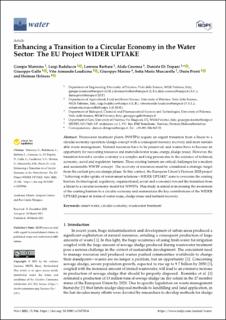Enhancing a Transition to a Circular Economy in theWater Sector: The EU Project WIDER UPTAKE
| dc.contributor.author | Mannina, Giorgio | |
| dc.contributor.author | Badalucco, Luigi | |
| dc.contributor.author | Barbara, Lorenzo | |
| dc.contributor.author | Cosenza, Alida | |
| dc.contributor.author | Di Trapani, Daniele | |
| dc.contributor.author | Gallo, Giuseppe | |
| dc.contributor.author | Laudicina, Vito Armando | |
| dc.contributor.author | Marino, Giuseppe | |
| dc.contributor.author | Muscarella, Sofia Maria | |
| dc.contributor.author | Presti, Dario | |
| dc.contributor.author | Helness, Herman | |
| dc.date.accessioned | 2021-04-21T06:43:08Z | |
| dc.date.available | 2021-04-21T06:43:08Z | |
| dc.date.created | 2021-04-19T05:11:16Z | |
| dc.date.issued | 2021 | |
| dc.identifier.issn | 2073-4441 | |
| dc.identifier.uri | https://hdl.handle.net/11250/2738742 | |
| dc.description.abstract | A novel approach for resource recovery includes forward osmosis (FO) as a concentration step in municipal wastewater treatment. The current study investigates different pre-treatment strategies including biological treatment with a moving-bed bioreactor (MBBR) at different loading rates and particle removal by filtration and sedimentation. Membrane performance and recovery potential for energy and nutrients were investigated in laboratory-scale FO experiments in batch mode using pre-treated municipal wastewater as feed and 35 g/L NaCl as a draw solution. Initial water fluxes were in the range of 6.3 to 8.0 L/(m2·h). The baseline fluxes were modelled to account for flux decline due to concentration effects and to enable the prediction of flux decline due to membrane fouling. Fouling-related flux decline varied from 0 to 31%. Both organic fouling and precipitation of CaCO3 and CaHPO4 were identified by using SEM–EDS. High-rate flushing resulted in complete flux recovery under most conditions. Scaling could be avoided by lowering the pH. Two operation strategies were tested to achieve this: (1) applying a bioreactor with a low organic loading rate to achieve high nitrification, and (2) adding a strong acid. A low organic loading rate and the use of additional particle removal were efficient measures that reduced organic/particulate fouling. The recovery potentials for COD and phosphorous in FO concentrate were close to 100%. | en_US |
| dc.language.iso | eng | en_US |
| dc.publisher | MDPI | en_US |
| dc.rights | CC BY 4.0 | * |
| dc.rights.uri | https://creativecommons.org/licenses/by/ 4.0/ | * |
| dc.subject | Smart water | en_US |
| dc.subject | Circular economy | en_US |
| dc.subject | Wastewater treatment | en_US |
| dc.title | Enhancing a Transition to a Circular Economy in theWater Sector: The EU Project WIDER UPTAKE | en_US |
| dc.type | Peer reviewed | en_US |
| dc.type | Journal article | en_US |
| dc.description.version | publishedVersion | en_US |
| dc.rights.holder | © 2021 by the authors | en_US |
| dc.subject.nsi | VDP::Teknologi: 500 | en_US |
| dc.source.volume | 13 | en_US |
| dc.source.journal | Water | en_US |
| dc.source.issue | 7 | en_US |
| dc.identifier.doi | 10.3390/w13070946 | |
| dc.identifier.cristin | 1904959 | |
| dc.relation.project | EC/H2020/869283 | en_US |
| dc.source.articlenumber | 946 | en_US |
| cristin.ispublished | true | |
| cristin.fulltext | original | |
| cristin.qualitycode | 1 |
Tilhørende fil(er)
Denne innførselen finnes i følgende samling(er)
-
Publikasjoner fra CRIStin - SINTEF AS [5638]
-
SINTEF Community [2233]

